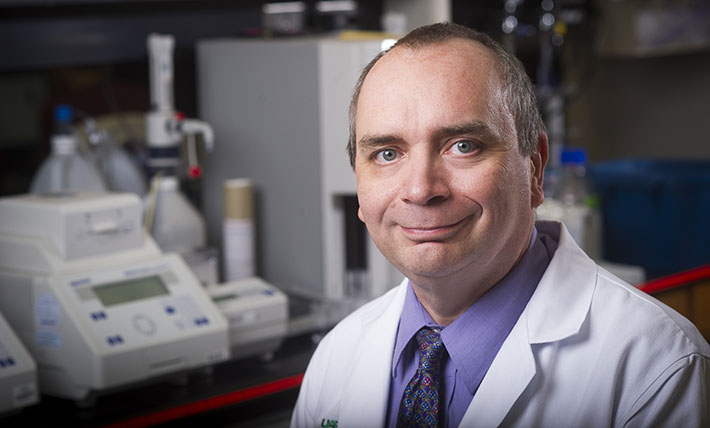
Toothy Truths
Solving Mysteries Through Forensic Dentistry
In the latest edition of the Manual of Forensic Odontology, 5th Edition (2013: CRC Press), co-editor Richard A. Weems, D.M.D. (UAB School of Dentistry), and some 25 chapter authors discuss new techniques and technologies, including advances in age estimation and bitemark analysis that lead to better and faster identification of unidentified individuals. The book was sponsored by the American Society of Forensic Sciences, and all proceeds from book sales go to that organization.
UAB Magazine: Why are teeth such useful forensic tools?
Weems: Long after we’re deceased and decomposed, the teeth are the last thing to survive. Even in a fire they’re very resistant, while fingerprints are gone in seconds. Also, almost everybody has some dental records, whereas not everybody has fingerprints on record. Interestingly, what we find most useful are fillings.

Ricardo Tapilatu: Graduate Student, UAB Department of Biology
By Susannah FeltsThe Pacific leatherback sea turtle, the largest of all living turtles, has great cultural and biological significance in Ricardo Tapilatu’s homeland of West Papua, Indonesia, but their numbers have been in decline for decades.
Tapilatu first saw the turtles’ eggs as a high school senior; years later he was able to visit the turtles’ last nesting stronghold, on two isolated beaches in West Papua. “When I looked at them face to face, I felt great sympathy for them,” he says. “I knew I had to do something.”

Fitness to Go
Wellness Hits the Road in Unique "Catering" Program
By Matt WindsorLooking for ways to stay fit at your desk? Want to know if the paleo diet is for real? Curious about CrossFit? Sarah Andreski, coordinator of fitness and wellness at the UAB Campus Recreation Center, has the answers. And she’ll bring them to you.

Brain Bodyguard
David Geldmacher Makes Moves Against Alzheimer's
By Robin Sutton Anders and Eleanor Spicer RiceAlzheimer’s disease affects millions of Americans and is the nation’s sixth leading cause of death. Alzheimer’s is marked by the accelerating death of brain cells, which means early detection is critical, says David Geldmacher, M.D., director of the UAB Division of Memory Disorders and Behavioral Neurology and Charles and Patsy Collat Professor of Neurology. Geldmacher, an expert on Alzheimer’s diagnosis and management, shares his latest research and reveals some common myths about the disease.
First Steps for a New Generation of Cancer Leaders
By Gail Allyn Short
 UAB's CaRES program is designed to attract a new generation of cancer researchers by pairing graduate students with UAB investigators. Ayesha Bryant (left), who now heads UAB clinical research in thoracic surgery, was a CaRES intern in graduate school. Last summer she worked with medical resident Patrick Yu (right). Michael Behring, M.S.P.H., had never considered a career as a cancer researcher. But one day, the UAB School of Public Health student, who was winding up his master’s degree in epidemiology, heard a professor talking about an intriguing UAB training program that provides cancer research experiences for graduate students in the schools of Medicine, Public Health, Dentistry, and Nursing.
UAB's CaRES program is designed to attract a new generation of cancer researchers by pairing graduate students with UAB investigators. Ayesha Bryant (left), who now heads UAB clinical research in thoracic surgery, was a CaRES intern in graduate school. Last summer she worked with medical resident Patrick Yu (right). Michael Behring, M.S.P.H., had never considered a career as a cancer researcher. But one day, the UAB School of Public Health student, who was winding up his master’s degree in epidemiology, heard a professor talking about an intriguing UAB training program that provides cancer research experiences for graduate students in the schools of Medicine, Public Health, Dentistry, and Nursing.
Behring says he was looking for just such a challenge. “I wanted to find a high goal and make a worthwhile contribution,” he says. Behring signed up for the UAB Cancer Research Experiences for Students (CaRES) program, a paid summer research training internship, and was hired by UAB epidemiologist Elizabeth Brown, Ph.D., his master’s program adviser, who was studying the genetic and molecular epidemiology of multiple myeloma. Under her mentorship, Behring recruited and interviewed patients, helped conduct data analysis, interacted with oncologists and epidemiologists, and performed administrative tasks associated with the research.
Now a doctoral student in epidemiology, Behring says the experience has helped him decide to become a cancer epidemiologist. “The program gave me a roadmap to figure out how to do cancer research and what it takes to participate in it,” he says. “It has given me good connections with different people and affirmed what I like about cancer research. Programs like this are one reason I stayed at UAB.”